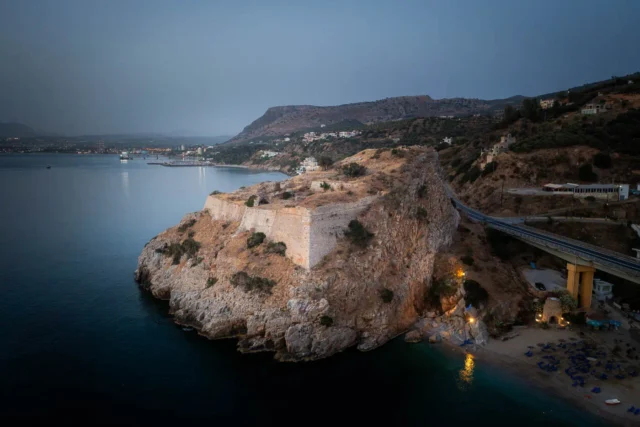


A Majestic Portal in Heraklion’s Walls
The Agios Georgios Gate, also known as the Lazaretto Gate or Maroula Gate, is a reminder of the size and strategic importance of Heraklion’s Venetian fortifications. Although it was demolished in the early 20th century, its historical significance and architectural legacy remain important in the city.
The Fortifications of Heraklion
Early Walls
The earliest walls of Heraklion date back to the Byzantine era. In 824 AD, Arab forces captured the city and built walls of unbaked bricks, surrounding the city with a defensive trench. The city, then known as Rabdh al-Khandaq (Trench Castle), became the capital of the Emirate of Crete.
In 961 AD, the Byzantines, led by Nikephoros II Phokas, recaptured Heraklion. They demolished the Arab fortifications and built a new fort named “Rokka.” As the settlement grew, the Byzantines constructed new walls on the site of the previous Arab walls. Remains of these Byzantine walls can still be found near Heraklion’s harbor.
Venetian Walls
In the early 13th century, the Republic of Venice took control of Crete. Initially, they utilized the existing Byzantine walls, making modifications as needed. However, the fall of Constantinople in 1453 and the rise of the Ottoman Empire prompted the Venetians to build a new, more formidable fortification system.
Construction of the new walls began in 1462. The walls were designed by prominent military architects Michele Sanmicheli and Giulio Savorgnan. They took over a century to complete, and various outworks were added over the years to further strengthen the fortifications.



Ottoman Rule and Modernization
The fifth Ottoman-Venetian War (1645-1669) saw the Ottoman navy arrive off Crete on June 23, 1645. While Chania (Canea) and the Fortezza of Rethymno fell to the Ottomans, the Venetian garrison in Heraklion (Candia) held out for 21 years, making the Siege of Candia the second-longest siege in history. The city surrendered in 1669, and the Venetians were allowed to leave peacefully, sparing the city from being sacked.
After the Ottoman conquest, the fortifications were repaired and maintained. The bastions were given Turkish names; for example, Martinengo Bastion became Giouksek Tabia. The Ottomans also built a small fort known as Little Koules near the Rocca al Mare (now known as the Koules Fortress). This was later demolished in 1936 during the city’s modernization.
The walls sustained damage from German aerial bombardment during World War II, but the damage was repaired. After the war, some outworks were demolished to accommodate modern buildings. There were even suggestions to demolish the entire city walls, but this never happened. Today, the walls remain largely intact, standing as some of the best-preserved Venetian fortifications in Europe.
Agios Georgios Gate
The Agios Georgios Gate, also known as the Lazaretto Gate or Maroula Gate, was one of the three main land gates in the Venetian walls of Heraklion. It was located on the eastern side of the walls, where Eleftherias Square stands today. The gate provided access to the eastern part of Crete and the leper colony (lazaretto), hence its alternative names.
Design and Features
The gate’s design was attributed to Giulio Savorgnan, a military engineer and architect who worked on the fortifications of Candia between 1562 and 1566. The gate featured a monumental facade with a central arched entrance flanked by two smaller doorways. Above the central archway was a relief depicting St. George on horseback.
The gate led to a long, vaulted passageway that served as a thoroughfare. This passageway still exists today, as it was not destroyed during the demolition of the gate’s facade.
Demolition and Rediscovery
In 1917, the Agios Georgios Gate was demolished to make way for the construction of Demokratias Avenue. The decision to destroy this historic landmark was met with criticism, but the gate was ultimately lost. However, the vaulted passageway remained intact, buried beneath Eleftherias Square.
In the early 2000s, during renovations of Eleftherias Square, the passageway was rediscovered and excavated. It has since been restored and is now open to the public. The passageway serves as a reminder of the gate’s former grandeur and its place in the city’s history.

Similarities with Famagusta Gate
The Agios Georgios Gate bears striking similarities to the Famagusta Gate in Nicosia, Cyprus. Both gates were designed by Giulio Savorgnan and share similar architectural features, such as the monumental facade with a central arched entrance and the long, vaulted passageway. The Famagusta Gate, however, remains intact and serves as a cultural center in Nicosia.
Key Points
- Construction Period: 1565
- Location: Eastern side of the Heraklion Walls (now Eleftherias Square)
- Historical Significance: Main land gate, designed by Giulio Savorgnan, connected Heraklion to eastern Crete
- Current Status: Demolished in 1917, vaulted passageway rediscovered and restored, open to the public
References
- Gerola, G. (1905). Monumenti Veneti nell’isola di Creta. Venice: Istituto Veneto di Scienze, Lettere ed Arti.
- Sythiakaki, V., Kanaki, E., & Bilmezi, C. (2015). Older Fortifications of Heraklion: A Different Approach Based on Recent Excavation Data. In Archaeological Work in Crete 3 (pp. 395-410). Rethymno: University of Crete.
- Gigourtakis, N. M. (Ed.). (2004). Heraklion and its Area: A Journey Through Time. Heraklion: Center for Cretan Literature.
- Cobham, C. D. (1908). Excerpta Cypria: Materials for a History of Cyprus. Cambridge: Cambridge University Press.
- Wikipedia































There are no comments yet.